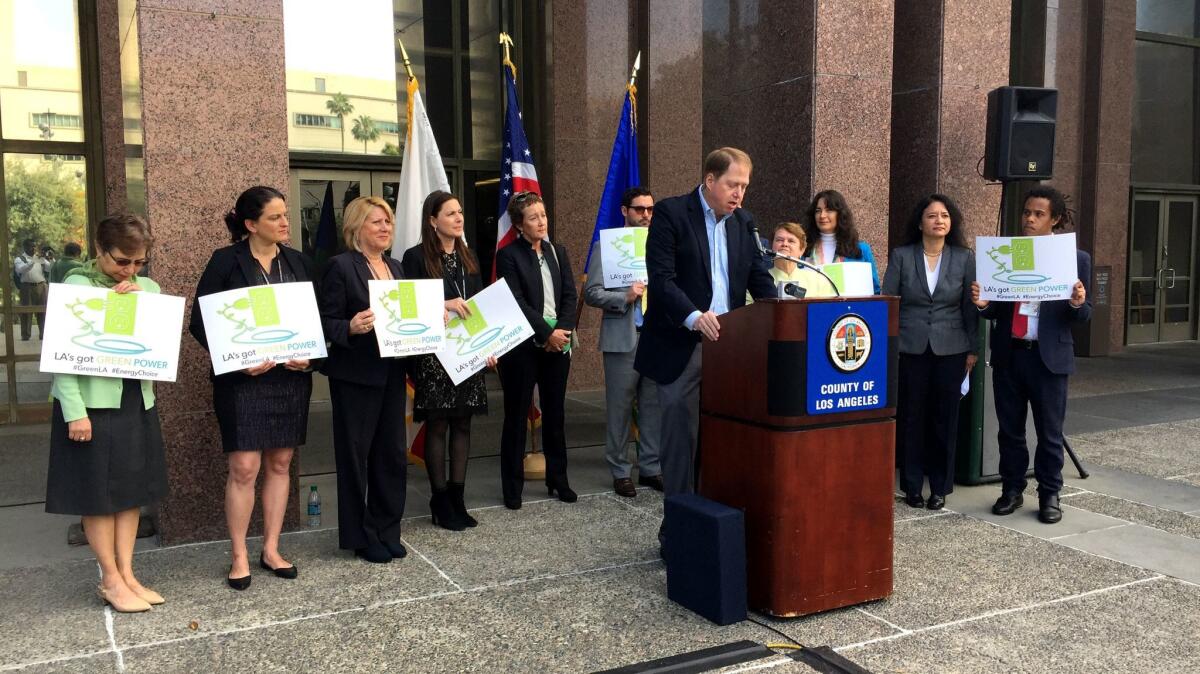Some of California’s major utilities are trying to block the growth of government-owned electricity programs

Some of California’s big shareholder-owned utilities are working to thwart the expansion of government-owned electricity programs, including Los Angeles County’s proposed end run on traditional power providers.
San Diego Gas & Electric Co. and Pacific Gas & Electric Co. are seeking amendments to state legislation or even a separate bill before the session ends Sept. 15 that will impose a moratorium on the so-called community choice aggregation programs operated by local governments as alternatives to existing power companies. Southern California Edison so far has taken a wait-and-see stance.
For the record:
8:22 a.m. Nov. 16, 2024An earlier version of this article stated that the county intends to phase in the program over three years. The pahse-in will occur in 2018.
The legislative effort has been dubbed the Freeze Bill for proposing to put the choice program expansion on hold, at least until the state develops what the utilities believe are appropriate fees to be paid by customers who leave for government-run providers. Some discussions have included language applying the moratorium to any community choice program not delivering electricity as of Sept. 1.
The community choice aggregation movement, which now includes Los Angeles County, is the latest potential blow to the shareholder-owned utilities, which have endured a dramatic shift in their industry with the proliferation of rooftop solar, improved energy efficiency, use of smart technology and the advent of battery storage that enables consumers to store electricity in their garages.
The technological advances have led to declining or flat usage in recent years of electricity produced by the utility companies. An industry report referred to these advances as “disruptive” technologies.
Although the shareholder-owned utilities say they support consumer choice, they insist that the current regulatory framework creates inequities for those who want to stay with their existing power provider.
“A diverse range of organizations, including seniors, small business, labor and consumer groups believes the current [system], which is supposed to ensure equity, is broken,” said Helen Gao, an SDG&E spokeswoman. “SDG&E agrees with these organizations, and believes we are headed for a major problem if regulators don’t fix the … issue soon.”
Southern California Edison said there is concern about how costs are managed and has communicated with lawmakers about the issue.
“SCE is not actively supporting a specific bill at this time on CCA-related matters, but continues to monitor bills and proposed legislation with a focus on protecting its customers,” Edison said in a statement.
At issue are obligations the utilities already have that need payment -- in particular, contracts for energy that the power providers secured years ago at prices that are higher than what the government-run programs are able to secure today.
If customers fleeing the shareholder utilities for the government-run providers don’t help cover the costs, those who remain with Edison, SDG&E or PG&E could face higher bills, the utilities argue.
Proponents of the government-run choice programs say they believe some reasonable compensation for the utilities to cover their costs is fine. But the utilities already receive adequate compensation, said Shalini Swaroop, deputy general counsel for the state’s oldest choice program in Marin County, called MCE.
“Traditionally, MCE has argued that the fee is too high and it affects our customers disproportionately,” Swaroop said. “MCE does not believe a freeze is needed. The Public Utilities Commission is currently examining the power charge indifference adjustment fee.”
MCE customers currently pay about $160 a year to PG&E in compensation after having left the utility.
Swaroop said MCE has been raising the issue of the exit fees for the last five years with no resolution, so the move for a moratorium now doesn’t make much sense.
A moratorium would affect MCE, as it is planning to add as many as nine cities, which have some 1 million people.
Perhaps the biggest concern for the utilities is the decision by Los Angeles County to create a community choice aggregation program. It has the potential to be the state’s largest.
Right now, four areas have signed up for the county program — West Hollywood, Calabasas, South Pasadena and Rolling Hills Estates, representing 1.2 million residents, or more than 250,000 residential and commercial accounts. The county intends to phase in the program in 2018.
The change in provider isn’t overwhelmingly apparent to consumers, other than the size of the bill.
In the case of Los Angeles County customers, electricity will still be delivered by Edison over its existing power lines. Edison will also continue to read the meters and send the bills.
But the county utility will buy the electricity from the market or under contract. The county can choose as much green energy as it wants and even build solar projects in the future.
Los Angeles County Supervisor Sheila Kuehl, who helped lead the effort to establish a choice program in the county, said the shareholder-owned utilities are simply “freaked out” at the idea of competition.
“When you’re used to having a monopoly, competition is a very scary thing,” Kuehl said. She said the effort to seek the moratorium in the waning days of the legislative session was troubling.
“They decided to take what I think is a fairly sneaky tack,” Kuehl said.
For more energy news, follow Ivan Penn on Twitter: @ivanlpenn
ALSO
Patients pay the price when hospital giants buy up independent doctor practices
Amazon is searching for new headquarters, and L.A. wants to be in the running
More to Read
Inside the business of entertainment
The Wide Shot brings you news, analysis and insights on everything from streaming wars to production — and what it all means for the future.
You may occasionally receive promotional content from the Los Angeles Times.











